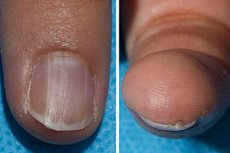New publications
Benign nail condition is associated with a rare cancer syndrome
Last reviewed: 02.07.2025

All iLive content is medically reviewed or fact checked to ensure as much factual accuracy as possible.
We have strict sourcing guidelines and only link to reputable media sites, academic research institutions and, whenever possible, medically peer reviewed studies. Note that the numbers in parentheses ([1], [2], etc.) are clickable links to these studies.
If you feel that any of our content is inaccurate, out-of-date, or otherwise questionable, please select it and press Ctrl + Enter.

Scientists at the National Institutes of Health (NIH) have found that having a benign nail abnormality may lead to a diagnosis of a rare inherited disorder that increases the risk of developing cancers of the skin, eyes, kidneys, and tissues lining the chest and abdomen (such as the mesothelium).
The disease, known as BAP1 tumor predisposition syndrome, is caused by mutations in the BAP1 gene, which normally functions as a tumor suppressor, among other functions.
The study results were published in the journal JAMA Dermatology and presented at the annual meeting of the Society for Investigative Dermatology (SID 2024), which was held in Dallas from May 15 to 18.
The researchers made the discovery by chance while studying participants enrolled in a screening study for BAP1 variants at the NIH Clinical Center. As part of the study, dermatology screening was performed at enrollment and annually for participants aged 2 years and older. The current study included 47 people with BAP1 tumor predisposition syndrome from 35 families.
"When asked about his nail health during his baseline genetic evaluation, the patient remarked that he had noticed subtle changes in his nails," said study co-author and genetic counselor Alexandra Lebenson, MS, of the NIH's National Cancer Institute (NCI). "His comment prompted us to systematically evaluate other participants for nail changes and identify this new observation."
Biopsies of the nail and underlying nail bed in several participants confirmed the researchers' suspicions of a benign tumor-like abnormality known as onychopapilloma. This condition causes a colored band (usually white or red) to appear along the length of the nail, thickening of the nail beneath the discoloration, and thickening at the end of the nail. It usually affects only one nail.
However, among study participants with a known BAP1 tumor predisposition syndrome aged 30 years or older, 88% had onychopapillomas involving multiple nails. The researchers suggest that nail screening may be particularly valuable for patients with a personal or family history of melanoma or other potential BAP1-associated malignancies.
"This observation is rare in the general population, and we believe that the presence of nail changes consistent with onychopapillomas on multiple nails should raise suspicion for BAP1 tumor predisposition syndrome," said Edward Cowan, MD, chief of dermatology consultation services at the NIH's National Institute of Arthritis and Musculoskeletal and Skin Diseases (NIAMS).
"This discovery is an excellent example of how interdisciplinary teams and natural history studies can reveal new knowledge about rare diseases," said Raffit Hassan, MD, co-author of the study and principal investigator of the clinical protocol in which these patients were enrolled.
